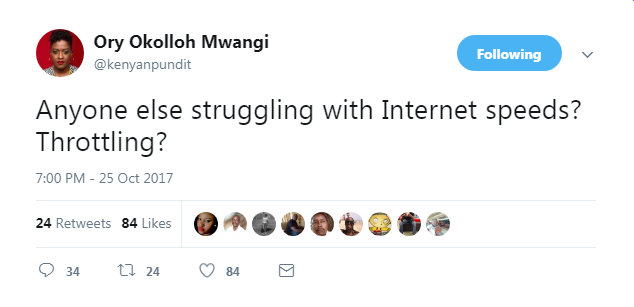Internet Speed Throttling Surrounding Repeat Election?
- Robert Muthuri |
- October 29, 2017 |
- Elections,
- Information Controls

On the eve of the fresh presidential elections in Kenya, Internet users reported slow Internet speeds while accessing social media and streaming platforms.1 Network performance fluctuates, especially when more subscribers come online, for example during major events. That ISPs have the capability to discretely throttle their users’ bandwidth is no secret, justified as de-congesting the network or for pressing clients towards more expensive plans, a major contention of the net neutrality principle. Throttling has also been used to control information during political processes. There are documented instances of throttling being used to limit the exchange of multimedia over social media during protests across the world.2 In Kenya, if the claims made on the eve of elections were to be confirmed, they would amount to limitations of freedom of speech online, a right entrenched in Article 33 of the Constitution.
As part of our mandate to investigate the intersection of ICTs and human rights, we are keen to research and document such instances. This helps to confirm or deny such grave allegations against ISPs. To that end, we have been running OONI’s software tests during the electioneering period to collect such evidence of internet censorship. Specifically, we have been running Network Diagnostic Tests (NDT) which are designed to measure the speed and performance of networks by connecting to M-Lab servers close to the user, and by subsequently uploading and downloading random data. In doing so, NDT collects TCP/IP low level information that is useful for examining and characterizing the quality of the network path between the user and the M-Lab server.3

The foregoing figure presents preliminary test data on the Safaricom network from the month of October in the Nairobi area. The average download speed is 4.58 Mbps and the average upload speed is 6.09 Mbps. However, there are concerns that usually, throttling will occur during demonstrations particularly in the Central Business District (CBD). In that regard, the median speeds are 2.8 Mbps (download) and 3.8 Mbps (upload). Safaricom now offers 4G+(150 Mbps) and 4G (60-100 Mbps). It is a fair assumption that speeds are not ubiquitously available across Nairobi. Even assuming a 3G network capable of 21 Mbps, our preliminary figures can be interpreted as signs of throttling on the network. However, the results could also have been influenced by network congestion and other infrastructure-related factors. Also, there are unconfirmed reports of throttling targeting individuals’ devices.
The figure above shows the download speeds for Safaricom, Telkom and Airtel respectively while the figure below shows the upload speeds in that regard. Sometimes the NDT test results in a error and hence a nought on the vertical scale for that particular data point.

More research is needed and we are building on our efforts to determine the nature of throttling practices currently being conducted by ISPs and thereby to differentiate those that are business-driven from those that are censorship-driven. In the interests of transparency, we call on ISPs to publish their capping and throttling practices at a sufficient level of detail in order to differentiate themselves. Internet users in Kenya can also run NDT tests on their mobile phones by downloading OONI app from the stores.4 When more people run tests, they give a wider pool of vantage points to objectively make conclusions.
We’d like to have your comments and thoughts so kindly join the conversation in the comments section below or via our social media channels.
Footnotes
1. See for example this tweet with experiences of Internet connection speed. Accessed 27 October 2017 https://twitter.com/kenyanpundit/status/923217714281361409
2. See, for example, Freedom House FOTN 2016 with a focus on Ethiopia, Brazil and Kasmir Accessed 27 October 2017 https://freedomhouse.org/report/freedom-net/freedom-net-2016
3. NDT was originally developed by The Internet2 Project and is currently maintained by Measurement Lab (M-Lab). For more, see https://www.measurementlab.net/tests/ndt/
4. Android and Apple applications can be accessed here: https://ooni.torproject.org/post/ooni-mobile-app/

Kenyans sent over 202,483 tweets on Oct 26 compared to Aug 8. -Nendo
Internet speed throttling during the election period?
Internet speed throttling during the election period? | KICTANET
Julius Outa
Robert Muthuri